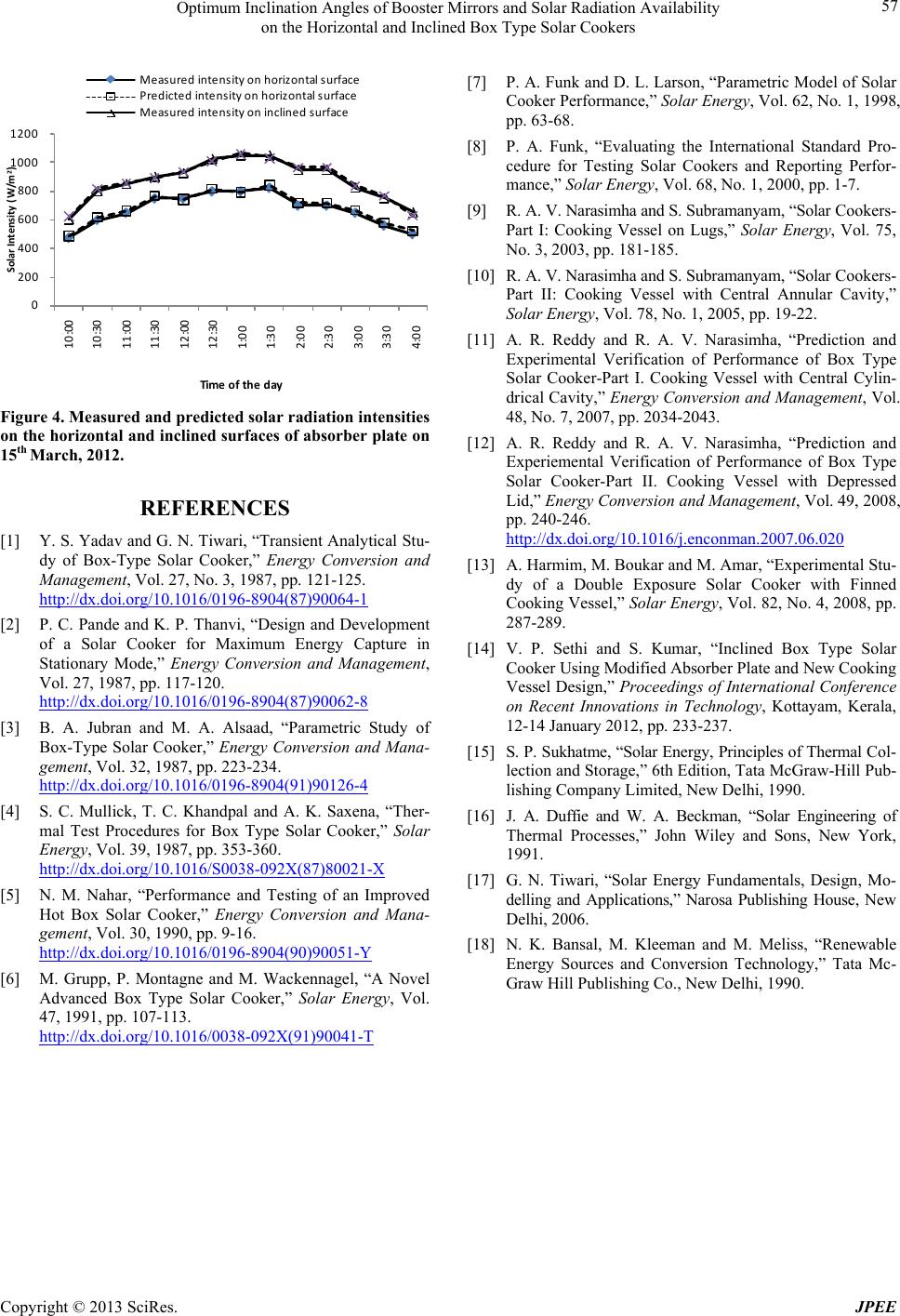
Optimum Inclination Angles of Booster Mirrors and Solar Radiation Availability
on the Horizontal and Inclined Box Type Solar Cookers
Copyright © 2013 SciRes. JPEE
Figure 4. Measured and predict ed sol ar r adi ation i nte nsit ie s
on the horizontal and inclined surfaces of absorber plate on
15th March, 2012.
REFERENCES
[1] Y. S. Yada v and G. N. Tiwari, “Transient Analytical St u-
dy of Box-Type Solar Cooker,” Energy Conversion and
Management, Vol. 27, No. 3, 1987, pp. 121-125.
http://dx.doi.org/10.1016/0196-8904(87)90064-1
[2] P. C. Pande and K. P. Thanvi, “Design and Development
of a Solar Cooker for Maximum Energy Capture in
Stationary Mode,” Energy Conversion and Management,
Vol. 27, 1987, pp. 117-120.
http://dx.doi.org/10.1016/0196-8904(87)90062-8
[3] B. A. Jubran and M. A. Alsaad, “Parametric Study of
Box-Type Solar Cooker,” Energy Conversion and Mana-
gement, Vol. 32, 1987, pp. 223-234.
http://dx.doi.org/10.1016/0196-8904(91)90126-4
[4] S. C. Mullick, T. C. Khandpal and A. K. Saxena, “Ther-
mal Test Procedures for Box Type Solar Cooker,” Solar
Energy, Vol. 39, 1987, pp. 353-360.
http://dx.doi.org/10.1016/S0038-092X(87)80021-X
[5] N. M. Nahar, “Performance and Testing of an Improved
Hot Box Solar Cooker,” Energy Conversion and Mana-
gement, Vol. 30, 1990, pp. 9-16.
http://dx.doi.org/10.1016/0196-8904(90)90051-Y
[6] M. Grupp, P. Montagne and M. Wackennagel, “A Novel
Advanced Box Type Solar Cooker,” Solar Energy, Vol.
47, 1991, pp. 107-113.
http://dx.doi.org/10.1016/0038-092X(91)90041-T
[7] P. A. Funk and D. L. Larson, “Parametric Model of Solar
Cooker Performance,” Solar Energy, Vol. 62, No. 1, 1998,
pp. 63-68.
[8] P. A. Funk, “Evaluating the International Standard Pro-
cedure for Testing Solar Cookers and Reporting Perfor-
mance,” Solar Energy, Vol. 68, No. 1, 2000, pp. 1-7.
[9] R. A. V. Narasimha and S. Subramanyam, “Solar Cookers-
Part I: Cooking Vessel on Lugs,” Solar Energy, Vol. 75,
No. 3, 2003, pp. 181-185.
[10] R. A. V. Narasimha and S. Subramanyam, “Solar Cookers-
Part II: Cooking Vessel with Central Annular Cavity,”
Solar Energy, Vol. 78, No. 1, 2005, pp. 19-22.
[11] A. R. Reddy and R. A. V. Narasimha, “Prediction and
Experimental Verification of Performance of Box Type
Solar Cooker-Part I. Cooking Vessel with Central Cylin-
drical Ca vity,” Energy Conversion and Management, Vol.
48, No. 7, 2007, pp. 2034-2043.
[12] A. R. Reddy and R. A. V. Narasimha, “Prediction and
Experiemental Verification of Performance of Box Type
Solar Cooker-Part II. Cooking Vessel with Depressed
Lid,” Energy Conversion and Management, Vol. 49, 2008,
pp. 240-246.
http://dx.doi.org/10.1016/j.enconman.2007.06.020
[13] A. Harmim, M. Boukar and M. Amar, “Experimental Stu-
dy of a Double Exposure Solar Cooker with Finned
Cooking Vessel,” Solar Energy, Vol. 82, No. 4, 2008, pp.
287-289.
[14] V. P. Sethi and S. Kumar, “Inclined Box Type Solar
Cooker Using Modified Absorber Plate and Ne w Cooking
Vessel Design,” Proceedings of International Conference
on Recent Innovations in Technology, Kottayam, Kerala,
12-14 January 2012, pp. 233-237.
[15] S. P. Sukhatme, “Solar Energy, Principles o f Thermal Col-
lection and Storage,” 6th Edition, Tata McGraw-Hill Pub-
lishing Company Limited, New Delhi, 1990.
[16] J. A. Duffie and W. A. Beckman, “Solar Engineering of
Thermal Processes,” John Wiley and Sons, New York,
1991.
[17] G. N. Tiwari, “Solar Energy Fundamentals, Design, Mo-
delling and Applications,” Narosa Publishing House, New
Delhi, 2006.
[18] N. K. Bansal, M. Kleeman and M. Meliss, “Renewable
Energy Sources and Conversion Technology,” Tata Mc-
Graw Hill Publishing Co., New Delhi, 1990.
Measured intensity on horizontal surface
Predicted intensity on horizontal surface
Measured intensity on inclined surface
10:00
10:30
11:00
11:30
12:00
12:30
1 :00
1 :30
2 :00
2 :30
3 :00
3 :30
4 :00